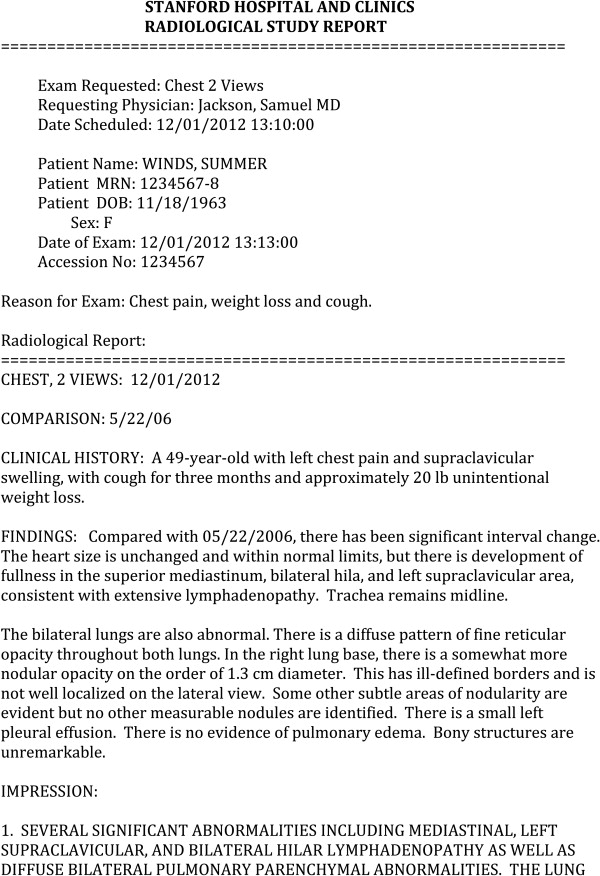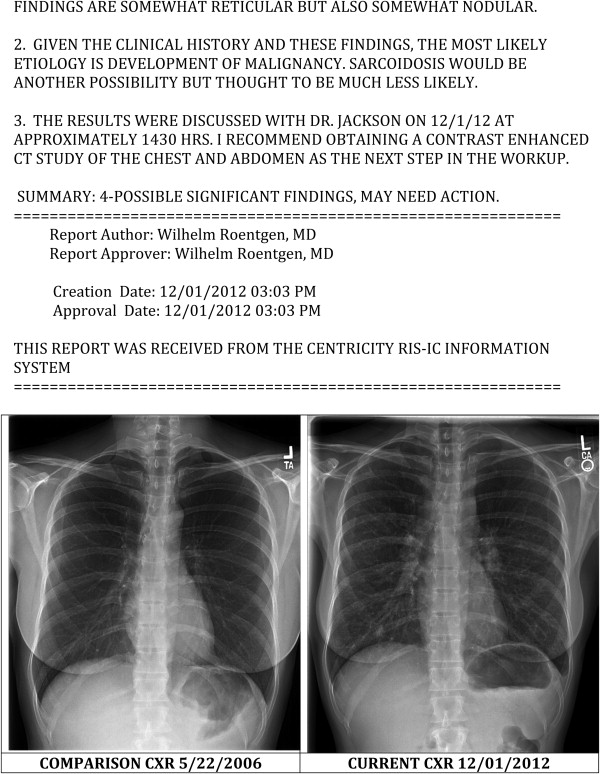Rationale and Objectives
Radiology reports are the major, and often only, means of communication between radiologists and their referring clinicians. The purposes of this study are to identify referring physicians’ preferences about radiology reports and to quantify their perceived value of multimedia reports (with embedded images) compared with narrative text reports.
Materials and Methods
We contacted 1800 attending physicians from a range of specialties at large tertiary care medical center via e-mail and a hospital newsletter linking to a 24-question electronic survey between July and November 2012. One hundred sixty physicians responded, yielding a response rate of 8.9%. Survey results were analyzed using Statistical Analysis Software (SAS Institute Inc, Cary, NC).
Results
Of the 160 referring physicians respondents, 142 (89%) indicated a general interest in reports with embedded images and completed the remainder of the survey questions. Of 142 respondents, 103 (73%) agreed or strongly agreed that reports with embedded images could improve the quality of interactions with radiologists; 129 respondents (91%) agreed or strongly agreed that having access to significant images enhances understanding of a text-based report; 110 respondents (77%) agreed or strongly agreed that multimedia reports would significantly improve referring physician satisfaction; and 85 respondents (60%) felt strongly or very strongly that multimedia reports would significantly improve patient care and outcomes.
Conclusions
Creating accessible, readable, and automatic multimedia reports should be a high priority to enhance the practice and satisfaction of referring physicians, improve patient care, and emphasize the critical role radiology plays in current medical care.
Traditional, text-only radiology reports are the major, and often only, means of communication between radiologists and their referring clinicians . In the era of nearly ubiquitous electronic access to radiology reports and the increasing use of teleradiology, there has been a decline in meaningful, direct in-person consultations at a time when the perceived value of a radiologist in patient care has never been more important to radiologists’ survival, both from an economic perspective and in the more far-reaching effort to maintain the status of the diagnostic imaging specialist as a central participant in patient care . And, although advances in image display and distribution has made some radiology images more readily available to a subset of referring clinicians, the concomitant increase in imaging data generated during each study (with thin-section multidetector computed tomography [CT] and magnetic resonance imaging [MRI] routinely including more than 1000 images per study) has make the task of reviewing complete imaging studies cumbersome and ultimately unrewarding for clinicians .
Despite the clear importance of the imaging report and despite radiologists’ daily work in a field defined by rapid progression of new techniques and innovative digital tools, most radiologists continue to create reports in a manner strikingly similar to that of their predecessors practicing 100 years ago . One way to leverage technologic advancement to improve communication of radiologic findings is through the introduction of multimedia reports, in which key images (including annotated images, maximum intensity projections, and three-dimensional postprocessed images) are embedded in a radiology report that also contains text and is easily accessible to all referring physicians .
Get Radiology Tree app to read full this article<
Get Radiology Tree app to read full this article<
Materials and methods
Get Radiology Tree app to read full this article<
Get Radiology Tree app to read full this article<
Get Radiology Tree app to read full this article<
Results
Get Radiology Tree app to read full this article<
Get Radiology Tree app to read full this article<
Get Radiology Tree app to read full this article<
Get Radiology Tree app to read full this article<
Discussion
Get Radiology Tree app to read full this article<
Get Radiology Tree app to read full this article<
Get Radiology Tree app to read full this article<
Get Radiology Tree app to read full this article<
Get Radiology Tree app to read full this article<
Get Radiology Tree app to read full this article<
Get Radiology Tree app to read full this article<
Acknowledgments
Get Radiology Tree app to read full this article<
Appendix 1 Survey Questions and Answers
Get Radiology Tree app to read full this article<
Get Radiology Tree app to read full this article<
Get Radiology Tree app to read full this article<
Get Radiology Tree app to read full this article<
Get Radiology Tree app to read full this article<
Get Radiology Tree app to read full this article<
Get Radiology Tree app to read full this article<
Get Radiology Tree app to read full this article<
Get Radiology Tree app to read full this article<
Get Radiology Tree app to read full this article<
Get Radiology Tree app to read full this article<
Get Radiology Tree app to read full this article<
Get Radiology Tree app to read full this article<
Get Radiology Tree app to read full this article<
Get Radiology Tree app to read full this article<
Get Radiology Tree app to read full this article<
Get Radiology Tree app to read full this article<
Get Radiology Tree app to read full this article<
Get Radiology Tree app to read full this article<
Get Radiology Tree app to read full this article<
Get Radiology Tree app to read full this article<
Get Radiology Tree app to read full this article<
Get Radiology Tree app to read full this article<
Get Radiology Tree app to read full this article<
Get Radiology Tree app to read full this article<
Get Radiology Tree app to read full this article<
Get Radiology Tree app to read full this article<
Get Radiology Tree app to read full this article<
Appendix 2
Get Radiology Tree app to read full this article<
Get Radiology Tree app to read full this article<
References
1. Naik S.S., Hanbidge A., Wilson S.R.: Radiology reports: examining radiologist and clinician preferences regarding style and content. AJR Am J Roentgenol 2001; 176: pp. 591-598.
2. Reiner B., Siegel E.: Radiology reporting: returning to our image-centric roots. AJR Am J Roentgenol 2006; 187: pp. 1151-1155.
3. Reiner B., Siegel E., Protopapas Z., et. al.: Impact of filmless radiology on the frequency of clinician consultations with radiologists. AJR Am J Roentgenol 1999; 173: pp. 1169-1172.
4. Boland G.W.: Visibility of radiologists: helping to secure your future. AJR Am J Roentgenol 2009; 192: pp. 1373-1374.
5. Iyer V.R., Hahn P.F., Blaszkowsky L.S., et. al.: Added value of selected images embedded into radiology reports to referring clinicians. J Am Coll Radiol 2010; 7: pp. 205-210.
6. Gagliardi R.A.: The evolution of the X-ray report. AJR 1995; 164: pp. 501-502.
7. Gelfand D.W., Schwarz D.L., Ott D.J.: The illustrated radiology report. AJR Am J Roentgenol 1996; 167: pp. 1099-1100.
8. Martino A. Sketching a new reality: what will the radiology report of the future look like? ACR Bulletin March 9, 2012. Available at: http://www.acr.org/News-Publications/News/News-Articles/2012/ACR-Bulletin/201203-Rad-Report-of-Future .
9. Plumb A.A., Grieve F.M., Khan S.H.: Survey of hospital clinicians’ preferences regarding the format of radiology reports. Clin Radiol 2009; 64: pp. 386-394.
10. Gunderman R., Ambrosius W.T., Cohen M.: Radiology reporting in an academic children’s hospital: what referring physicians think. Pediatr Radiol 2000; 30: pp. 307-314.
11. Johnson A.J., Ying J., Swan J.S., et. al.: Improving the quality of radiology reporting: a physician survey to define the target. J Am Coll Radiol 2004; 1: pp. 497-505.
12. Clinger N.J., Hunter T.B., Hillman B.J.: Radiology reporting: attitudes of referring physicians. Radiology 1988; 169: pp. 825-826.
13. Channin D.S., Mongkolwat P., Kleper V., et. al.: The caBIG™ Annotation and Image Markup Project. J Digit Imaging 2010; 23: pp. 217-225.
14. Yang G.L., Aziz A., Narayanaswami B., et. al.: Informatics in radiology (infoRAD): multimedia extension of medical imaging resource center teaching files. Radiographics 2005; 25: pp. 1699-1708.
15. Crane K, Branstetter B, Chang P. Zero-penalty authoring of multimedia radiology reports. Presented at the Annual Meeting of the Radiological Society of North America; Chicago, IL 2005.

